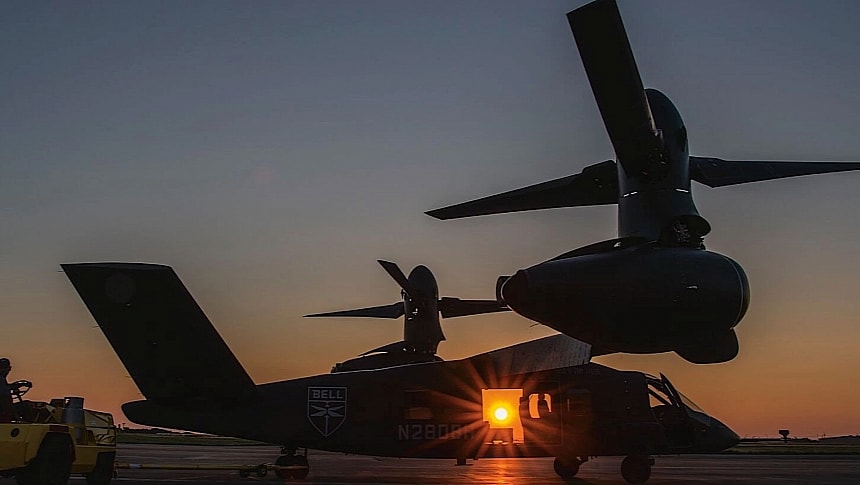It's been a while since we last heard anything of interest about the Future Long-Range Assault Aircraft (FLRAA) program run by the U.S. Army. So much time, in fact, we kind of forgot there's a Black Hawk helicopter replacement being cooked up under this moniker. Luckily, we were reminded of its existence last week, when the company that makes the new helo, Bell, announced yet another supplier for the project.
The Black Hawk is a helicopter that needs little introduction. Made by the one company which practically became synonymous with helicopters, Sikorsky, the aircraft rapidly became the backbone of militaries around the world, rolling off the assembly lines in pretty large numbers: some 4,000 of them were made to date.
But the Black Hawk has one thing going against it: time. The helicopter has been around ever since the 1970s, and despite constant upgrades there's only so much the military can do to keep it relevant. And that's why back in 2019 the FLRAA program was born.
After a bitter fight between some of the biggest players in aviation, the Army said back in 2022 that the one to make its shiny new helicopter is Bell, and that the aircraft itself would be the V-280 Valor. And that came as a sort of surprise, given how the Black Hawk is a conventional helo, while the Valor is a tiltrotor that from certain angles looks a bit like an Atreides ornithopter.
This design, though, comes with a number of advantages, the biggest of them all being that the machine can take off and land like a rotary wing aircraft, but then can transition to horizontal flight with capabilities comparable to a twin turboprop aircraft.
After being announced as the winner of the contract two years ago, Bell got to work to put the Valor together in production form, but the pace at which things are moving seems quite slow. For instance, the company announced in the spring of last year that the tiltrotor will be powered by Pratt & Whitney engines from a family developed for the High-Speed Vertical Takeoff and Landing (HSVTOL) program, and said not much else about it since.
This week we got word of who will be supplying the hardware meant to generate electricity for the aircraft will use: Safran. This crew will provide Bell with the starter-generation systems comprising a high-speed rotor and advanced power electronics.
The exact capabilities of the Valor are not yet known, but we do know some of the features the Army was looking for when it launched the search for the new helo, as well as some of the achievements Bell made with a prototype of the Valor.
The tiltrotor should be capable of reaching a top speed of 345 mph (555 kph), more than enough to beat the speed record for helicopters set by the Airbus X3, which moved at 293 mph (472 kph) during a run in 2013.
The range of the Valor should be 575 miles (925 km), and it should be large enough to accommodate a crew of four and an additional 12 soldiers. In cargo configuration, the helicopter should be able to lift as much as 12,000 lbs (5.4 metric tons) of cargo.
The V-280 is expected to be ready for duty sometime next decade, making for a relatively long development process.
But the Black Hawk has one thing going against it: time. The helicopter has been around ever since the 1970s, and despite constant upgrades there's only so much the military can do to keep it relevant. And that's why back in 2019 the FLRAA program was born.
After a bitter fight between some of the biggest players in aviation, the Army said back in 2022 that the one to make its shiny new helicopter is Bell, and that the aircraft itself would be the V-280 Valor. And that came as a sort of surprise, given how the Black Hawk is a conventional helo, while the Valor is a tiltrotor that from certain angles looks a bit like an Atreides ornithopter.
This design, though, comes with a number of advantages, the biggest of them all being that the machine can take off and land like a rotary wing aircraft, but then can transition to horizontal flight with capabilities comparable to a twin turboprop aircraft.
After being announced as the winner of the contract two years ago, Bell got to work to put the Valor together in production form, but the pace at which things are moving seems quite slow. For instance, the company announced in the spring of last year that the tiltrotor will be powered by Pratt & Whitney engines from a family developed for the High-Speed Vertical Takeoff and Landing (HSVTOL) program, and said not much else about it since.
This week we got word of who will be supplying the hardware meant to generate electricity for the aircraft will use: Safran. This crew will provide Bell with the starter-generation systems comprising a high-speed rotor and advanced power electronics.
The exact capabilities of the Valor are not yet known, but we do know some of the features the Army was looking for when it launched the search for the new helo, as well as some of the achievements Bell made with a prototype of the Valor.
The tiltrotor should be capable of reaching a top speed of 345 mph (555 kph), more than enough to beat the speed record for helicopters set by the Airbus X3, which moved at 293 mph (472 kph) during a run in 2013.
The range of the Valor should be 575 miles (925 km), and it should be large enough to accommodate a crew of four and an additional 12 soldiers. In cargo configuration, the helicopter should be able to lift as much as 12,000 lbs (5.4 metric tons) of cargo.
The V-280 is expected to be ready for duty sometime next decade, making for a relatively long development process.







